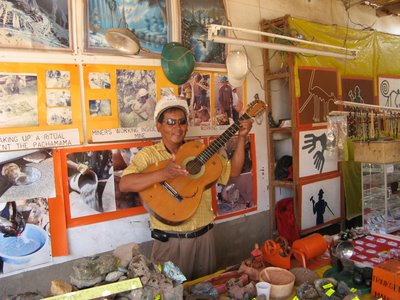Day 9 18th November 2006 Coca Leaves and Lamas - Arequipa to Coporaque (Altitude 3,250m)
Continuing our journey higher into the Andes we reached 5,000m today on route, most of us passed out on the bus before we arrived at a cafe close by. Here we were able to stock up on coca leaves, the main ingredient for cocaine but used legally in Peru as a source of energy and a cure for the affects of altitude sickness. Coca is available in serveral forms including
- Raw leaves - the most effective but sour tasting leaving your mouth numb and your tounge green
- Candy & Toffee
- Biscuits
- Tea
At the cafe the tea was served fast and furious to the bus loads of toursits but also to the local flock of sheep who seemed to be addicted to the stuff. One of the sheep was using every tactic possible to get the leaves, hiding under the table and then tipping over the cups. The sheep was shortly joined by a llama, equally addicted to the coca leaves.
 The effect of all the left over leaves on the sheep can be seen below.
The effect of all the left over leaves on the sheep can be seen below.
I found the tea to be incredibly effective soothing the headaches quickly with the added bonus of also soothing my stomach. I also took the opportunity to aquire a local style hat made from Alpaca wool (a close relation of the lama)
I would say now that we in are the Peru I was expecting, vast mountins interlaced with rurual villages steeped in history. With villagers still working the land as the Incas had done 500 years ago, using terraces and irregation systems, with water supplied from the snow on the mountian peaks.

On route to Coporaque we stopped for a bite to eat and for the first time ever I ordered soup. We were met outside the restaurant by two little girls in traditional Peruvian dress accompanied by their pet lama, posing for photos, at a cost of course. The locals in all the villages are very friendly people, many of which asking their friends to take pictures of us with them.

On arriving at our hotel in Coporaque we were gretted by the pet llama before emabarking on a 2 hour walk to try and adjust to the altitude. The village is surrounded by Inca graves completed with bones but no gold. According to the locals there are some tombs still intact with gold and silver but their location is a closely guarded secret as grave robbing is still active throughout Peru.
Highlights: Beautiful scenary, lots of llamas and the friendly locals





 The effect of all the left over leaves on the sheep can be seen below.
The effect of all the left over leaves on the sheep can be seen below.















 Before arriving in Nasca we spent the afternoon on dune buggies and sand boarding, well sledging.
Before arriving in Nasca we spent the afternoon on dune buggies and sand boarding, well sledging.  Highlights: Sand buggies and sand boarding
Highlights: Sand buggies and sand boarding 



 Miraflores is where the rich and famous of Lima hangout, with penthouse appartments overlooking the Pacfic ($200k) and an american style mall complete with Starbucks, which Shelley dragged me into before a visit to the cinema (not quite treacking in the Andean Mountains)
Miraflores is where the rich and famous of Lima hangout, with penthouse appartments overlooking the Pacfic ($200k) and an american style mall complete with Starbucks, which Shelley dragged me into before a visit to the cinema (not quite treacking in the Andean Mountains)

